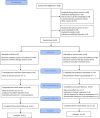The effect of eye movement desensitization on neurocognitive functioning compared to retrieval-only in PTSD patients: a randomized controlled trial
- PMID: 39731040
- PMCID: PMC11673372
- DOI: 10.1186/s12888-024-06420-9
The effect of eye movement desensitization on neurocognitive functioning compared to retrieval-only in PTSD patients: a randomized controlled trial
Abstract
Background: There is robust evidence that posttraumatic stress disorder (PTSD) is associated with neurocognitive deficits, such as executive dysfunction or memory dysfunction. Eye Movement Desensitization and Reprocessing (EMDR) is an evidence-based treatment for PTSD, in which eye movements (EMs) are performed during traumatic memory retrieval. We examined whether Eye Movement Desensitization (EMD) improves neurocognitive functioning in PTSD patients, in comparison with a retrieval-only control condition without EMs.
Methods: Adult patients with PTSD (N = 91) were randomized into EMD (N = 47) or retrieval-only (N = 44). Data were collected at baseline (T0), one-week post-treatment (T1), one-month follow-up (T2), and at three-month follow-up (T3). Outcome measures were the California Verbal Learning Test (CVLT), the Trail Making Test (TMT), and the Digit Span Subtest of the Wechsler Adult Intelligence Scale fourth edition (WAIS-IV). We conducted linear mixed model to analyse the main outcomes.
Results: There was a main effect of time, indicating improvements for both the EMD and retrieval-only groups in CVLT scores, TMT A, TMT B and Digit Span score of WAIS-IV (Bonferroni-adjusted p's < 0.001) from T0 to T3. There were no effects of group (p = .64) or group by time on CVLT total trial A (T3; p = .34), delay A (T3; p = .76), TMT A (T3; p = .61), TMT B (T3: p = .58), and Digit Span scores (T3; p = .78) of the WAIS-IV, indicating no significant differences between groups on any of the outcomes.
Conclusion: Comparing EMD and retrieval-only did not show evidence for additive effects of EMs on the treatment of PTSD in terms of improvements in neurocognitive functioning. Thus, treatments based on retrieval of traumatic memories may be used to improve neurocognitive functioning in patients with PTSD.
Clinical trial registration: The trial was registered 19/12/2017 at ClinicalTrials.gov, identifier [ISRCTN55239132].
Keywords: Attention; Executive function; Eye movement desensitization; Information processing speed; Learning memory; Neurocognitive functioning; Posttraumatic stress disorder; Working memory.
© 2024. The Author(s).
Conflict of interest statement
Declarations. Ethics approval and consent to participate: The studies involving human participants were reviewed and approved by the Research Ethics Committee of Universitas Padjadjaran Bandung on 2 July 2018 (Document number: 3 35/UN6.KEP/EC/2018). The patients/participants provided their written informed consent to participate in this study. Consent for publication: N/A. Competing interests: The authors declare no competing interests.
Similar articles
-
The Effectiveness of Eye Movement Desensitization for Post-traumatic Stress Disorder in Indonesia: A Randomized Controlled Trial.Front Psychol. 2022 Apr 25;13:845520. doi: 10.3389/fpsyg.2022.845520. eCollection 2022. Front Psychol. 2022. PMID: 35548495 Free PMC article.
-
Eye Movement Desensitization (EMD) to reduce posttraumatic stress disorder-related stress reactivity in Indonesia PTSD patients: a study protocol for a randomized controlled trial.Trials. 2021 Mar 4;22(1):181. doi: 10.1186/s13063-021-05100-3. Trials. 2021. PMID: 33663549 Free PMC article.
-
Stress and stress reactivity in posttraumatic stress disorder (PTSD) following eye movement desensitization (EMD): A randomized controlled trial.J Behav Ther Exp Psychiatry. 2025 Dec;89:102052. doi: 10.1016/j.jbtep.2025.102052. Epub 2025 Jul 16. J Behav Ther Exp Psychiatry. 2025. PMID: 40706348 Clinical Trial.
-
What is the role of eye movements in eye movement desensitization and reprocessing (EMDR) for post-traumatic stress disorder (PTSD)? a review.Behav Cogn Psychother. 2013 May;41(3):290-300. doi: 10.1017/S1352465812000793. Epub 2012 Oct 29. Behav Cogn Psychother. 2013. PMID: 23102050 Review.
-
Psychological therapies for the treatment of post-traumatic stress disorder in children and adolescents (Review).Evid Based Child Health. 2013 May;8(3):1004-116. doi: 10.1002/ebch.1916. Evid Based Child Health. 2013. PMID: 23877914 Review.
References
-
- American Psychiatric Association. Diagnostic and Statistical Manual of Mental Disorders (DSM-5). Fifth edit. Washington, DC: American Psychiatric Publishing; 2013.
-
- Harnett NG, Goodman AM, Knight DC. PTSD-related neuroimaging abnormalities in brain function, structure, and biochemistry. Exp Neurol [Internet]. 2020;330(October 2019):113331. Available from: 10.1016/j.expneurol.2020.113331 - PubMed
-
- Polak AR, Witteveen AB, Reitsma JB, Olff M. The role of executive function in posttraumatic stress disorder: A systematic review. J Affect Disord [Internet]. 2012;141(1):11–21. Available from: 10.1016/j.jad.2012.01.001 - PubMed
Publication types
MeSH terms
Grants and funding
LinkOut - more resources
Full Text Sources
Medical


